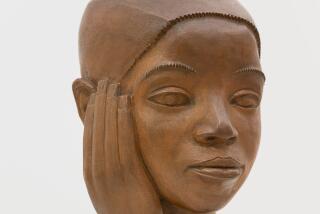Known for Works in Wood : L.A. Inventor, Sculptor Jan de Swart Dies at 79
Jan de Swart, an inventor whose lifelong fascination with the woods and metals he found about him took him into a separate career as an acclaimed and experimental sculptor, has died after suffering a heart attack.
He was 79 and died April 15 in Pasadena.
Born in Holland, De Swart’s basic training came at the hands of a master woodcarver in his native land. And although he was never formally schooled in engineering, he held patents on hundreds of items ranging from seals that held ships together in turbulent seas to plastic lenses used to bring life to such intriguing characters as the animated “Mr. Magoo.”
But in artistic circles De Swart was noted for his innovative use of laminated woods and metal molds that produced creations ranging from a 60-foot clock tower in the Fresno Mall to aluminum castings that hang on a mammoth 120-foot wall outside what once was Henry Kaiser’s penthouse in Oakland.
Apprenticed to Carver
De Swart was orphaned at a young age and apprenticed to a carver of liturgical sculpture in Holland. There, he said in a 1978 interview with The Times, “our work was very traditional. . . . It was sent to cathedrals.”
As a boy, he chanced to view a figure of Christ in stone done by Jacob Epstein. “It had an agony of expression that was almost painful to look at.”
De Swart credited that experience with giving him the courage to break away from tradition, “to put more of my own feelings into each sculpture.”
In 1929, at age 21, De Swart set sail for America and eventually came to California. Alone and without funds or friends, he saw a store in Los Angeles with a Dutch windmill at its entrance. Assuming there were friendly Dutch inside, De Swart entered the Van de Kamp’s bakery and was befriended by the owners.
He worked for a time with an Italian furniture maker and on the side began to experiment with blocks of a new material called plastic.
World War II brought with it a demand for De Swart’s inventive skills, and in 1943 alone he registered more than 100 patents, among them adaptations of rivets and grommets that were easier to install on ships and airplanes.
Home Was Workshop
Working out of the home in Eagle Rock that he occupied until his death, he would make prototypes with simple machinery, using his eye for sculpture in place of the advanced mathematics and cumbersome computers other inventors were then utilizing.
According to a catalogue prepared for his final art show at the Laguna Art Museum, he made fasteners for aircraft, appliance shelves and doors, plastic tops for medicine bottles and cans and many other items still in use.
After the war, he began to exhibit the abstract forms he had fashioned from plastic, and in 1944 his first one-man show was staged at a Pasadena gallery. In 1945, the Pasadena Art Museum showed his work, which by now included the precious woods he had learned to carve as a boy.
Times art writer Suzanne Muchnic, in reviewing the Laguna show, found in his craggy reliefs, spindly towers and wavy columns the “ghosts of Surrealists--Miro, Dali, Ernst, Arp, Brancusi and Picasso.”
‘Mystery That Clarifies’
De Swart said, “Abstract art is like the mystery in poetry: mystery that clarifies.”
His works began appearing in many of Los Angeles’ finest homes, and he won architectural awards. He had also developed a method of casting metal into wood--a method that scarred the wood but, said his wife, Ursula, “left it full of surprises.”
In the 1970s he returned to the spiritual subjects of his boyhood and rendered a series of sculptures of Biblical characters.
In addition to his wife, De Swart is survived by a son and granddaughter.
More to Read
The biggest entertainment stories
Get our big stories about Hollywood, film, television, music, arts, culture and more right in your inbox as soon as they publish.
You may occasionally receive promotional content from the Los Angeles Times.










